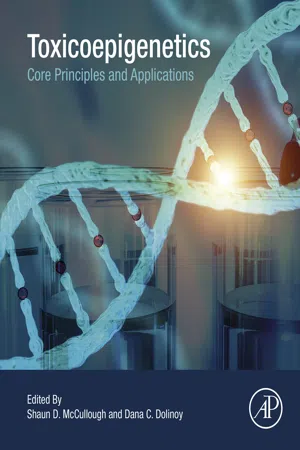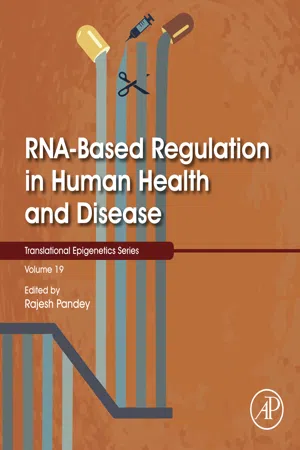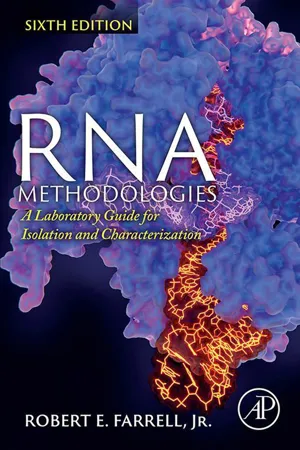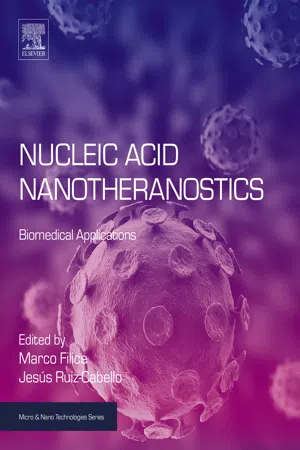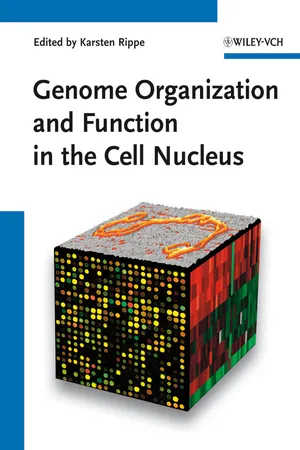Biological Sciences
Non-Coding RNA
Non-coding RNA (ncRNA) refers to RNA molecules that are not translated into proteins. Despite not coding for proteins, ncRNAs play crucial roles in regulating gene expression, chromatin structure, and various cellular processes. They are involved in diverse functions such as gene silencing, RNA processing, and post-transcriptional regulation, making them important players in the complex landscape of cellular biology.
Written by Perlego with AI-assistance
Related key terms
11 Key excerpts on "Non-Coding RNA"
- eBook - ePub
- Anita Göndör(Author)
- 2016(Publication Date)
- Academic Press(Publisher)
4 ]. In recent years, “the RNA world” has received increased attention from the scientific community, which has changed our view of the central dogma of molecular biology. RNA is thus not solely an intermediate between the DNA sequence and proteins, but has crucial roles in development and cell differentiation.It is, however, not a new concept that ncRNAs can have important cellular functions. The so-called “structural ncRNAs” have thus been extensively studied in the last 50 years and include transfer RNAs associated with aminoacid transport, ribosomal RNAs involved in protein synthesis, small nuclear RNAs with a role in RNA splicing or small nucleolar RNAs linked to RNA modifications. Although these structural ncRNAs are ubiquitously expressed in all cell types and play essential roles in development and cell differentiation, they will not be discussed further in this chapter, which instead focuses on the classification and functions of the “regulatory ncRNAs” in diverse transcriptional and posttranscriptional processes.9.1.2. Classification of Regulatory Noncoding RNAs
In contrast to structural ncRNAs, “regulatory” ncRNAs have a well-defined expression pattern that depends on the developmental stage and cell type. Whereas most of the regulatory ncRNAs have yet to be functionally characterized, they have been classified based on their size with an arbitrary cut-off of 200 nucleotides (nt), distinguishing between short ncRNAs (<200 nt) and long noncoding RNAs (lncRNAs) (> 200 nt). Most of the studies in the last decade have been focused on the shortest of all ncRNAs: microRNAs (miRNA). MiRNAs are small ncRNAs approximately 22 nucleotides in length, which are processed from precursor RNAs by the RNAse III enzymes DROSHA and DICER, and function as endogenous posttranscriptional silencers of their target genes [5] . MiRNAs are expressed in a tissue-dependent manner and are important regulators of several cellular processes, including proliferation, differentiation, apoptosis, and development [6] . The deregulation of miRNA expression is often linked to human developmental defects and diseases through imperfect pairing with their respective target mRNAs, which can have deleterious consequences on miRNA functions, such as translational repression, regulation of mRNA decay or cleavage [7] . Due to their impact on genetic engineering tools, special attention has been paid in the last decade to the small-interfering RNAs (siRNAs). SiRNAs are 20–24 nt in length, and they are also generated by Dicer processing from long double-stranded RNAs and small hairpin RNAs [3] . Although siRNAs can be involved in different regulatory functions, their most significant role is mediated by the RNA interference (RNAi) pathway. SiRNAs thus interfere with the expression of specific genes with complementary nucleotide sequences mainly by promoting mRNA cleavage via the RNA-induced silencing complex (RISC), Argonaute-2 (AGO-2) and other auxiliary RISC proteins. This property has been employed as a tool for achieving transient gene knockdown in in vitro cell cultures. Other notable small ncRNAs include the Piwi-interacting RNAs, which are ncRNAs of 24–30 nt in length and, in contrast to miRNA and siRNA, are generated in a Dicer-independent manner. They received their name because of their ability to form a complex with the PIWI family of proteins [3] , and act as suppressors of transposable element expression and also prevent transposon jumping [3] - eBook - ePub
Toxicoepigenetics
Core Principles and Applications
- Shaun D. McCullough, Dana Dolinoy(Authors)
- 2018(Publication Date)
- Academic Press(Publisher)
Section 3 Noncoding RNAsPassage contains an image
Chapter 3-1The Role of Noncoding RNAs in Gene Regulation
Emily Woolard⁎ ; Brian N. Chorley†⁎ Oak Ridge Institute for Science and Education at US Environmental Protection Agency, RTP, NC, United States† National Health and Environmental Effects Research Laboratory, US Environmental Protection Agency, RTP, NC, United StatesAbstract
The genome contains regions of noncoding RNAs (ncRNAs) that have critical regulatory roles for gene transcription and protein translation. In this chapter, we will briefly review the forms of ncRNA with a focus on microRNAs (miRNAs), small ncRNAs that have important roles in regulating gene expression and cellular phenotype and may serve as important biomarkers in toxicology. In addition, we highlight current theories of biogenesis and emerging areas of research describing the varied and unique biological roles of miRNA, including enhanced function through molecular feedback loops and cell-to-cell communication through biofluids.Keywords
Noncoding RNAs; MicroRNA; Biogenesis; Gene regulation; Feedback loops; Biofluids; BiomarkersOutline- Introduction
- Overview of Noncoding RNAs
- Transfer and Ribosomal RNA
- Long Noncoding RNA (lncRNA)
- Short Noncoding RNA
- MicroRNA Discovery
- MicroRNA Biogenesis and Regulation
- Pri-miRNA Transcription and Regulation
- Pri-miRNA Processing and Nuclear Export
- Maturation of miRNA RISC Formation
- Regulation of Mature miRNA by ceRNA
- Biological Roles of MicroRNA
- Gene Target Silencing
- Enhanced Biological Impact of miRNAs Through Feedback Loops
- Biofluid-Based Biomarkers and Cell Communication
- Concluding Remarks and Future Directions
- Acknowledgments
- References
Acknowledgments
The authors wish to thank Dr. Stephanie Padilla and Dr. Charles Wood for their critical reviews of this manuscript. We are also grateful to Molly Windsor and John Havel for their assistance with the figures. This manuscript has been reviewed by the US Environmental Protection Agency and approved for publication. Approval does not signify that the contents reflect the views of the agency, nor mention of trade names or commercial products does not constitute endorsement or recommendation of use. - eBook - ePub
- (Author)
- 2020(Publication Date)
- Academic Press(Publisher)
Chapter 2: Non-Coding RNAs: ever-expanding diversity of types and functions
Subhash Chandra Lakhotiaa,∗,1, Bibekanand Mallickb,1and Jyoti Royba Cytogenetics Laboratory, Department of Zoology, Banaras Hindu University, Varanasi, Uttar Pradesh, Indiab RNAi & Functional Genomics Laboratory, Department of Life Science, National Institute of Technology, Rourkela, Odisha, India∗ Corresponding authorAbstract
Recent advances in high-throughput technologies have revealed that although major portions of genomes in all eukaryotes transcribe, only a very small fraction of the transcripts encodes proteins. The rest, with no protein coding ability, are noncoding RNAs (ncRNAs). Numerous studies in recent decades have shown that, besides the classically known ribosomal (rRNA), transfer (tRNA), small nucleolar (snoRNA), small nuclear (snRNA) and small Cajal body-associated RNAs (scaRNA), a large number of novel ncRNAs exist and perform multifaceted biological functions. In parallel with the diversity of their origins, mechanisms of actions and functions, different schemes have been proposed to classify the new ncRNAs. An early empirical, but still used, grouping of the novel ncRNAs was based on their size, which led to their classification as small and long ncRNAs (sncRNA and lncRNAs), respectively. The microRNAs (miRNAs), small interfering RNAs (siRNAs) and piwi interacting RNAs (piRNAs) are the major types of sncRNAs. In contrast, the lncRNAs display enormous diversity, which encouraged different researchers to group them under different categories in relation to their genomic origin, spatial location, association with specific cellular compartment, mode of action, etc. However, these terminologies have mostly been short-lived because of the pleiotropic nature of mechanisms of actions and consequent diversity of functions elicited by the same lncRNA gene. In addition, many ncRNAs do not fall into the empirically defined sncRNAs and lncRNAs. This chapter reviews diversity of the ncRNAs types discovered during the past 2–3 decades, and, taking some specific examples, illustrates their varied and pleiotropic modes of actions in normal cell regulation and in diseases. Coming years would unravel further diversity in the mechanisms of actions and pervasive roles of ncRNAs in cellular networks that regulate stemness, cell differentiation, and homeostasis. - eBook - ePub
RNA Methodologies
A Laboratory Guide for Isolation and Characterization
- Robert E. Farrell Jr.(Author)
- 2022(Publication Date)
- Academic Press(Publisher)
Chapter 12miRNA and other noncoding RNAs
Abstract
Comprehensive transcriptome deep-sequencing has revealed that most of the typical eukaryotic genome is transcriptionally active, producing an astonishing array of both large and small noncoding RNA (ncRNA). Although the functions of many ncRNA are unclear, in general ncRNAs have the ability to influence gene expression at the transcriptional and post-transcriptional levels. Important categories of ncRNA are sncRNA, lncRNA, lincRNA, Y RNA, and circRNA. One type of small noncoding transcript, microRNA (miRNA), has been documented to have important regulatory roles in the modulation of gene expression by profoundly influencing the stability and translatability of mRNA. miRNAs are endogenous, noncoding regulatory molecules with a typical length of 20–22 nts. They are known to govern cellular and organism physiology at the levels of cell proliferation, differentiation, signal transduction, cellular senescence, apoptosis, and the initiation and progression of the disease state, to name a few examples. Thousands of miRNAs have already been identified in many organisms and have been added to the rapidly expanding miRNA database known as miRBase.Keywords
Noncoding RNA (ncRNA); Y RNA; lncRNA; lincRNA; microRNA (miRNA); miRNA profiling; gene expression; transient repression; circRNA; miRNA spongeRationale
Accompanying the completion of the 13-year human genome sequencing project in 2003 was the then shocking revelation that there are relatively few protein-encoding genes distributed across 24 distinct chromosomes. The 20,000+ genes in this category, which encode approximately 50,000 different mRNAs, occupy roughly 4% of the genome; this is far fewer than expected, given that there are more than 1 million known functional proteins. In sharp contrast to what was commonly held only a few years ago, comprehensive transcriptome deep-sequencing has revealed that most of the typical eukaryotic genome is transcriptionally active, producing an astonishing array of noncoding RNA (ncRNA). The majority of the transcriptome consists of staggering numbers of ncRNA, the major categories of which are small noncoding RNA (sncRNA; <200 nts), long noncoding RNA (lncRNA; 200+nts), long intergenic RNA (lincRNA; 200+nts), circular RNA (circRNA; variable size), catalytic RNA (Fig. 12.1 - eBook - ePub
- Francesc Piferrer, Hanping Wang(Authors)
- 2023(Publication Date)
- Wiley(Publisher)
This chapter follows the ncRNA definition by length since distinguishing categories per functionality presents difficulties due to the crossover of properties. Thus, sncRNAs are less than 200 nucleotides (nt) and are further categorized again according to their length, while long lncRNAs are noncoding transcripts with a length of more than 200 nt. Some of the best‐known and well‐studied lncRNA are shown in Figure 3.3. Major terms and ncRNA types are described in Box 3.1. 3.2 Major Types of ncRNAs 3.2.1 Small Noncoding RNA (sncRNA) The main role of sncRNAs is the regulation of gene expression through either RNA interference, RNA modification, or spliceosomal involvement. Consequently, their expression can change according to the individual’s particular condition. The most extensively studied sncRNA class is microRNAs (miRNAs) and will therefore be described in more detail within this chapter. Another upcoming popular sncRNA group discussed in more detail here is the class of P‐element‐induced wimpy testis (Piwi)‐interacting RNA (piRNA). Other sncRNA classes are the small nuclear RNA (snRNA), small nucleolar RNA (snoRNA), transfer RNA (tRNA), and transfer RNA (tRNA)‐derived fragments (tRFs), which are shortly discussed hereafter. Figure 3.3 Schematic overview of RNA types divided into noncoding and coding RNAs. Noncoding RNA is further grouped into small noncoding RNA (sncRNA), including microRNA (miRNA), P‐element‐induced wimpy testis (Piwi)‐interacting RNA (piRNA), transfer RNA (tRNA), small nuclear RNA (snRNA), small nucleolar RNA (snoRNA), as well as transfer RNA‐derived RNA fragments (tRFs), and long noncoding RNA (lncRNA), comprising ribosomal RNA (rRNA), circular RNA (circRNA), intergenic lncRNAs (lincRNAs), intronic lncRNAs, antisense lncRNAs (aslncRNA), bidirectional lncRNAs, and enhancer RNAs (eRNAs). Box 3.1 Major ncRNA Terms Circular RNA (circRNA): A unique type of noncoding RNA molecule - eBook - ePub
Nucleic Acid Nanotheranostics
Biomedical Applications
- Marco Filice, Jesús Ruiz-Cabello(Authors)
- 2019(Publication Date)
- Elsevier(Publisher)
6- –
Long noncoding RNAs (lncRNAs) more than 200 nt long. This ncRNA category has been discovered more recently. Despite being the largest part of ncRNAs, the role of lncRNAs in biological processes is still little known. Nevertheless, plenty of studies are exploring their function and the emerging data reveal their importance in gene expression control.7 Their flexible scaffold structure and their nucleic acid nature confer on them the dual ability to interact with proteins, such as transcription factors, and with specific RNA or DNA target sequences, finally resulting in the regulation of gene expression at multiple levels, transcriptional and posttranscriptional.8 , 92 Micro-RNAs
miRNAs are a class of small noncoding RNAs identified as posttranscriptional regulators of gene expression. Mature microRNAs are constituted by a double strand RNA (19–22 nt long). They participate in posttranscriptional processing of protein-coding genes via direct interaction with target mRNAs and induction of mRNA translation inhibition by cleavage or translational repression.10 To this day, more or less 2500 miRNAs have been identified in the human genome. The genes encoding for miRNAs are located either in nonprotein-coding parts of our genome or in overlap with protein-coding genes (often inside their introns). In the former case, they are transcribed independently from DNA or together with other miRNAs composing a miRNA cluster. In the latter case, they are transcribed together with the protein coding host gene and separated from mRNA by posttranscriptional processing mechanisms.11 Often, the mRNA and the miRNA encoded in the same locus supervise the same biological processes.12 - eBook - ePub
Vascular Smooth Muscle: Structure And Function In Health And Disease
Structure and Function in Health and Disease
- Chi-Ming Hai(Author)
- 2016(Publication Date)
- WSPC(Publisher)
Chapter 8
The Role of Non-Coding RNA in the Control of Vascular Contractility and Disease
C. J. Nicholson and K. G. MorganBoston University, Boston, Massachusetts, USAOver the last decade, the cellular impact of Non-Coding RNAs, defined as RNA molecules not translated into protein, have emerged as an area of great interest. Once thought to only regulate generic functions of cells, namely transcription, translation and splicing, several diverse functions of Non-Coding RNAs, such as described below for microRNAs and long Non-Coding RNAs, are now well established.11.MicroRNAs
By far the most studied of these molecules are microRNAs (miRNAs), a family of short (21–25 nucleotide) RNAs, which normally post-transcriptionally downregulate gene expression through interacting with the 3′ untranslated (3′ UTR) region of mRNA targets. The first miRNA, lin-4, was discovered more than 20 years ago to be important in C. Elegans larval development.2 The current release of the miRNA database (miRBase) has documented 2661 human miRNAs, which could collectively regulate the expression of thousands of protein-encoding genes with many cellular and developmental processes. However, it should be noted that the true functional importance of these miRNAs has yet to be fully determined.3 , 4 Each miRNA has only a moderate effect on gene expression of their targets, and hence provides a ‘fine-tuning’ role on gene expression.5 It is common, however, for one miRNA to influence multiple targets in the same biological pathway, and consequently miRNAs can have profound influences on gene expression.6 - eBook - ePub
- Robert A. Meyers(Author)
- 2014(Publication Date)
- Wiley-Blackwell(Publisher)
cis-Antisense RNAs4.1.1 Mode of Action 4.1.2 Specific and Global Antisense-Dependent Regulations4.2.1 Gene Expression Inhibition by ncRNAs 4.2.2 Activation of Gene Expression by ncRNAs 5 RNA Changing Protein Activities 5.1 Mimicking DNA Promoters 5.2 Mimicking Ribosome Binding Sequences 6 Concluding Remarks Acknowledgments References4.2 trans-Acting Noncoding RNAsRegulatory noncoding RNAA nonprotein-coding RNA molecule that controls biological processes by directly affecting the transcription, translation, or stability of another RNA, or by binding to proteins.trans-Antisense ncRNAA regulatory RNA that acts on an RNA molecule (target) that is encoded at a different locus.cisI-Antisense ncRNAA regulatory RNA that acts on the expression of the gene transcribed from the reverse complementary DNA strand.Regulatory 5′ untranslated regionA noncoding RNA sequence located at the 5′ end of a protein coding sequence within a messenger RNA, and controlling its expression.Open reading frameA nucleic sequence that starts with a translation initiation codon and ends with a translation stop codon, which can potentially be translated by the ribosome into a specific amino acid chain.Shine–Dalgarno sequenceAn RNA sequence recognized and bound by the 16S ribosomal RNA. The sequence is located upstream of the translation initiation codon (4–12 nt) within the ribosome binding site.Ribosome binding siteAn RNA sequence recognized and bound by the 30S ribosomal subunit to initiate translation. It generally extends from about − 30 nt to around +16 nt relative to the translation initiation codon. - eBook - ePub
- Suming Huang, Michael D. Litt, C. Ann Blakey(Authors)
- 2015(Publication Date)
- Academic Press(Publisher)
2] . These numbers vary, but reports indicate as much as 75% of the human genome is transcribed. The expansive transcriptome, as it can be referred, is also a fact for most commonly used model organisms throughout the biomedical research community. This pervasive transcription has led to a series of questions: do these RNAs code for a protein, what is the biological function of these RNAs, if any, and what is the molecular mechanism by which these RNAs execute that function? The majority of these newly discovered RNA molecules do not have any identifiable open reading frame, do not associate with the ribosomes, and many are nuclear localized. Thus, the consensus is that these represent noncoding RNAs (ncRNAs).In spite of the power of high-throughput sequencing to promote the discovery of newly identified biological molecules, the most well understood of these ncRNAs that affect chromatin structure were discovered without the aid of high-throughput DNA sequencing. These two very different ncRNAs are Xist and siRNAs. Xist was originally discovered in the early 1990s and is shown to be an ncRNA required for maintaining a silent X chromosome in mammals [3 –6] . This long ncRNA (17 kb in humans and 15 kb in mice) functions by coating the silent X chromosome and recruiting factors that promote heterochromatin.The other well-studied ncRNA was discovered using the model systems Arabidopsis thaliana and Caenorhabditis elegans . Using these genetic models, the observation was made that transgenes containing a high degree of homology to an endogenous gene were being transcriptionally silenced [7 –9] . Interestingly, this silencing extended to the endogenous counterpart of the transgene. The mechanism by which these genes were being silenced was ultimately shown to be due to the action of small RNAs, spanning 21–24 nucleotides in length. These were named small interfering RNAs (siRNAs), and the mechanism by which they silenced both the transgene and its endogenous counterpart in C. elegans was termed RNA interference (RNAi). The mechanism, as it was originally understood, acted to degrade the messenger RNA (mRNA) of these genes posttranscriptionally. This type of RNAi does not involve changes to chromatin structure. However, later work in another model organism, Schizosaccharomyces pombe , identified the RNAi machinery as being critical for the establishment and maintenance of heterochromatin at the centromere [10 ,11] . Over the past decade, the ability of the RNAi machinery to regulate chromatin structure has been extended to include regulation of genomic regions other than the centromere, and has also been extended to flies, mice, and humans [12] - Karsten Rippe, Karsten Rippe(Authors)
- 2012(Publication Date)
- Wiley-VCH(Publisher)
Figure 13.6a ).2. The ncRNA targets the transcriptional machinery or recruits a regulatory factor (Figure 13.6b ).3. They may also affect downstream processes such as splicing, nuclear export and mRNA stability (Figure 13.6b ).4. The ncRNA regulates nucleosome structure (Figure 13.6c ).5. The ncRNA regulates the higher order chromatin organization and nuclear localization (Figure 13.6d ) of its target and thereby influences gene expression.Table 13.1 Mechanisms of gene regulation by small and long Non-Coding RNAs.ncRNA Description of proposed mode of action Reference Transcription itself has regulatory function Yeast PHO5 and SER3 upstream transcripts Transcription of nc RNA changes chromatin plasticitiy [183, 184] β-Globin region, Ig-heavy chain V region DNA becomes accessible to binding proteins [185, 186] Tsix-mediated Xist regulation Readthrough of Xist gene/promoter leads to altered chromatin and Xist repression [160–162] Hox genes Continuous transcription prevents heterochromatin formation [177, 178, 180] Imprinted genes Transcription through regulatory region results in altered binding/activity of activating/repressing factors [187] Yeast fbp1+locus upsteam transcript Opening chromatin in fbp1+locus allowing accessibility [188] Interaction with the transcription machinery or recruitment of regulatory factors Exogenous siRNAs to initiation sites Inhibition of RNAP II binding to TATA box [110–112] siRNAs Inhibition of RNAP II elongation in C. elegans - eBook - ePub
Post-Transcriptional Gene Regulation
RNA Processing in Eukaryotes
- Jane Wu(Author)
- 2013(Publication Date)
- Wiley-Blackwell(Publisher)
Though ncRNAs have been discovered in large numbers, the field still lacks suitable approaches for functional screens on new ncRNAs. This is marked by the inability of genetic screens to uncover ncRNA functions due to their short length, greater tolerance to point mutations, functional redundancy, and lack of knowledge about their functions. Already the analysis of coding genes has taken a long time, and it is not to be expected that ncRNAs can be studied at a much higher rate. Therefore, it will be important to select promising targets to demonstrate new functions for representative ncRNAs. Analysis of a small fraction of ncRNAs could provide the ground for a more general understanding of their regulatory processes. In addition, an experimental verification of their coding potential only may not address all functions of transcripts. Considering “multifunctional transcripts,” the characterization of primary transcripts along with the mature RNAs derived thereof is an important requirement. This puts a strong emphasis on RNA processing and means of its analysis. Many of these processes are very fast, and specific inhibitors of RNA processing are in demand, for example, by knockdown of specific enzymes [92, 181, 209].A better understanding of ncRNA functions will help to develop knowledge-driven approaches to ncRNA discovery and characterization. Here, functional screening systems are in demand to characterize ncRNAs, or to screen for new ncRNAs in a biological context using knockdown and gain-of-function studies. Functional screens may provide alternatives to genetic screens to better link transcript discovery to functional analysis. Understanding the function of ncRNAs will be the entry into an RNA world with entirely new concepts on biological processes. There are exciting times ahead of us with more surprising discoveries to come in the RNA world.8.7 Note Added in Proof
The field of ncRNAs is developing very rapidly, mostly driven by new sequencing-based methods. Many important observations have been published since we had originally written this book chapter. Therefore, we want to point the reader at some recent reviews on some important aspects for updated views on these amassing developments.
Index pages curate the most relevant extracts from our library of academic textbooks. They’ve been created using an in-house natural language model (NLM), each adding context and meaning to key research topics.

